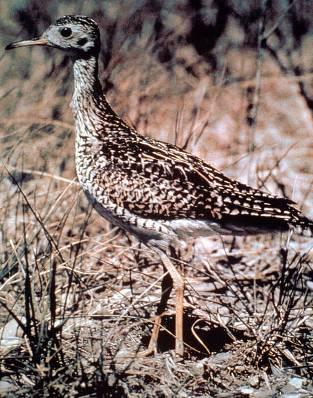Upland Sandpiper (Bartramia longicauda)
This article was originally published by the Washington Department of Fish and Wildlife as part of its annual report Threatened and Endangered Wildlife in Washington.

State Status: Endangered, 1981 (possibly extirpated)
Federal Status: None
Recovery Plans: State, 1995
The upland sandpiper may be extirpated as a breeding species in Washington. It is a medium-sized sandpiper that nests on grassland in North America, and winters on the pampas of South America. There are scattered historical breeding records for eastern Washington, it may have never been abundant, and apparently was rare throughout the 20th century in Washington. Habitat loss to development, grazing, and invasive knapweeds all may have contributed to the species’ extirpation from the state. A few birds nested in the Spokane Valley during the 1950s-1990s (McAllister 1995), with the last nesting record in 1993. The last sighting of an upland sandpiper in Spokane County was 2004. It is also apparently gone from Idaho (Mlodinow 2005).
Literature Cited
McAllister, K. R.1995. Washington state recovery plan for the upland sandpiper. Washington Department of Fish and Wildlife, Olympia, Washington. 50 pp.
Mlodinow, S. G. 2005. Upland sandpiper. Pp. 145 in T. R. Wahl, B. Tweit, and S. G. Mlodinow, eds. Birds of Washington: status and distribution. Oregon State University Press, Corvallis, Oregon.
Source: Washington Department of Fish and Wildlife. 2013. Threatened and Endangered Wildlife in Washington: 2012 Annual Report. Listing and Recovery Section, Wildlife Program, Washington Department of Fish and Wildlife, Olympia. 251 pp.

